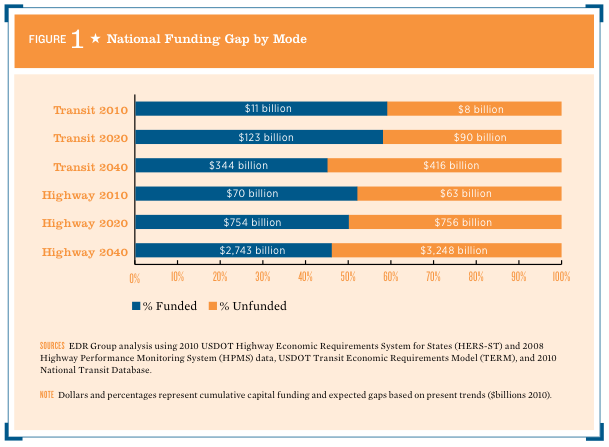AMERICAN SOCIETY OF CIVIL ENGINEERS
Executive Summary
The nation’s surface transportation infrastructure includes the critical highways, bridges, railroads, and transit systems that enable people and goods to access the markets, services, and inputs of production essential to America’s economic vitality. For many years, the nation’s surface transportation infrastructure has been deteriorating. Yet because this deterioration has been diffused throughout the nation, and has occurred gradually over time, its true costs and economic impacts are not always immediately apparent. In practice, the transportation funding that is appropriated is spent on a mixture of system expansion and preservation projects. Although these allocations have often been sufficient to avoid the imminent failure of key facilities, the continued deterioration leaves a significant and mounting burden on the U.S. economy. This burden will be explored further in this report.
Deteriorating conditions and performance impose costs on American households and businesses in a number of ways. Facilities in poor condition lead to increases in operating costs for trucks, cars, and rail vehicles. Additional costs include damage to vehicles from deteriorated roadway surfaces, imposition of both additional miles traveled, time expended to avoid unusable or heavily congested roadways or due to the breakdown of transit vehicles, and the added cost of repairing facilities after they have deteriorated as opposed to preserving them in good condition. In addition, increased congestion decreases the reliability of transportation facilities, meaning that travelers are forced to allot more time for trips to assure on-time arrivals (and for freight vehicles, on-time delivery). Moreover, it increases environmental and safety costs by exposing more travelers to substandard travel conditions and requiring vehicles to operate at less efficient levels. As conditions continue to deteriorate overtime, they will increasingly detract from the ability of American households and businesses to be productive and prosperous at work and at home.
This report is about the effect that surface transportation deficiencies have, and will continue to have, on U.S. economic performance. For the purpose of this report, the term “deficiency” is defined as the extent to which roads, bridges, and transit services fall below standards defined by the U.S. Department of Transportation as “minimum tolerable conditions” (for roads and bridges) and “state of good repair” for transit. These standards are substantially lower than ideal conditions, such as “free-flow,” that are used by some researchers as the basis for highway analysis. This report is about the effect these deficiencies have, and will continue to have, on U.S. economic performance.
In 2010, it was estimated that deficiencies in America’s surface transportation systems cost households and businesses nearly $130 billion. This included approximately $97 billion in vehicle operating costs, $32 billion in travel time delays, $1.2 billion in safety costs and $590 million in environmental costs.
In 2040, America’s projected infrastructure deficiencies in a trends extended scenario are expected to cost the national economy more than 400,000 jobs. Approximately 1.3 million more jobs could exist in key knowledge-based and technology-related economic sectors if sufficient transportation infrastructure were maintained. These losses are balanced against almost 900,000 additional jobs projected in traditionally lower-paying service sectors of the economy that would benefit by deficient transportation (such as auto repair services) or by declining productivity in domestic service related sectors (such as truck driving and retail trade). If present trends continue, by 2020 the annual costs imposed on the U.S. economy by deteriorating infrastructure will increase by 82% to $210 billion, and by 2040 the costs will have increased by 351% to $520 billion (with cumulative costs mounting to $912 billion and $2.9 trillion by 2020 and 2040, respectively).
The avoidable transportation costs that hinder the nation’s economy are imposed primarily by pavement and bridge conditions, highway congestion, and transit and train vehicle conditions that are operating well below minimum tolerable levels for the level of traffic they carry. If the nation’s infrastructure were free of deficient conditions in pavement, bridges, transit vehicles, and track and transit facilities, Americans would earn more personal income and industry would be more productive, as demonstrated by the gross domestic product (value added) that will be lost if surface transportation infrastructure is not brought up to a standard of “minimum tolerable conditions.” As of 2010, the loss of GDP approached $125 billion due to deficient surface transportation infrastructure.
Across the U.S., regions are affected differently by deficient and deteriorating infrastructure. The most affected regions are those with the largest concentrations of urban areas, because urban highways, bridges and transit systems are in worse condition today than rural facilities. Peak commuting patterns also place larger burdens on urban capacities. However, because the nation is so dependent on the Interstate Highway System, impacts on interstate performance in some regions or area types are felt throughout the nation. Nationally, for highways and transit, 630 million vehicle hours traveled were lost due to congestion in 2010. This total is expected to triple to 1.8 billion hours by 2020 and further increase to 6.2 billion hours in 2040. These vehicle hours understate person hours and underscore the severity of the loss in productivity.
About American Society of Civil Engineers
www.asce.org
“Founded in 1852, the American Society of Civil Engineers (ASCE) represents more than 147,000 members of the civil engineering profession worldwide, and is America’s oldest national engineering society. ASCE’s vision is to position engineers as global leaders building a better quality of life…Comprised of Regional Councils, Younger Member Councils, Sections, Branches, Student Chapters and Clubs and International Student Groups, the Society and its volunteers are fully engaged in making this a better world by design.”







 RSS Feed
RSS Feed